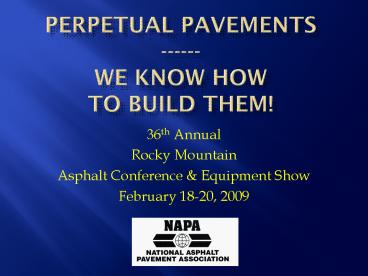Perpetual pavements we know how to build them - PowerPoint PPT Presentation
1 / 33
Title: Perpetual pavements we know how to build them
1
Perpetual pavements------we know howto build
them!
- 36th Annual
- Rocky Mountain
- Asphalt Conference Equipment Show
- February 18-20, 2009
2
Where are we?
- Perpetual Pavements have been defined.
- Perpetual Pavements exist.
- We know how to design them
- High volume
- Low volume
- We know how to specify mixes.
3
What is a Perpetual Pavement?
- A thick, well-designed, well-constructed asphalt
pavement. - Maintains low strains deep in the pavement.
- Precludes bottom-up distresses.
- Requires only periodic renewal of wearing course.
- Avoids costly reconstruction!
4
History of Perpetual Pavements
- 1960s Full-depth asphalt.
- Reduce overall material consumption.
- Reduce total cross-section.
- Reduce earth work.
- Working platform
- Thin granular layer
- Stabilized subgrade
- Unintended consequence Perpetual Pavements
5
Perpetual Pavement Award
- Started by the Asphalt Pavement Alliance in 2001.
- Road must be gt35 years old.
- No thickness increase gt4 inches.
- No overlay interval less than 13 years.
- Nominated by DOT.
6
Perpetual Pavement Awards
50 Awards since 2001
1 Award 2 Awards 3 Awards 5 Awards 6 Awards
7
Washington State Performance
8
Washington State Performance
9
Oregon Performance
10
Oregon Performance
11
Kansas Interstate Cost Performance, I-70, 40 years
12
40-75 mm SMA,
OGFC or Superpave
100 mm to 150 mm
Zone Of High Compression
High Modulus Rut Resistant Material (Varies As
Needed)
Durability Layer 75 - 100 mm
Max Tensile Strain
Pavement Foundation
13
Horz. Shear Stress Profile
HMA Surface
Peak Shear Stress
HMA Intermediate
HMA Base
14
Surface Course
- Exposed directly to traffic and climate
- High horiz. shear and vert. comp. stresses
- Thermal stresses most severe at surface
- Aggregate
- Crushed for high/med. traffic
- Some gravel OK for low vol. traffic
- Polymer Mod
- Reqd for high vol.
- Advisable for med. vol.
15
Vert. Compressive Stress
HMA Surface
Peak Vertical Stress
HMA Intermediate
HMA Base
16
Pavement Temp. Fluctuation
HMA Surface
HMA Intermediate
Winter
Summer
Depth
HMA Base
Temperature
17
Dense-Graded Mixes
- Workhorse of HMA Industry
- Can be used as
- Structural layer
- Friction layer
- Leveling course
- Patching
- Densely packed aggregate particles
- Relatively impermeable
18
SMA Mixes
- Gap-graded HMA
- Maximum rutting resistance durability
- Stone-on-stone agg skeleton
- Rich mix of AC, filler, fibers and modifiers
- High performance mix
- Reduced reflection cracking
19
Mix Type - SMA
- Cubical, low abrasion crushed stone and
manufactured sand - 100 fractured faces
- No natural sand
- High polish value
- Stiff matrix
- Sand/asphalt/MF/ additives
- Reduces draindown
- Increase asphalt content
20
Perpetual Pavement Design
- Three Important Things
- Foundation
- Traffic
- Materials
- One Important Issue
- How Thick?
21
Perpetual PavementversusConventional Design
22
Mechanistic Performance Criteria
Thick or Stiff HMA
Base (as required)
Subgrade
23
Normal Range for
Normal Range for
1200
1200
1200
Fatigue Testing
Fatigue Testing
1000
1000
1000
NCAT Endurance Limit Between 100 and 250µe
800
800
800
Strain, (10E-06)
Strain, (10E-06)
Strain, (10E-06)
600
600
600
400
Endurance Limit
400
Endurance Limit
400
Endurance Limit
200
200
200
0
0
0
1000
100000
10000000
1.1E08
1000
100000
10000000
1.1E08
1000
100000
10000000
1.1E08
Number of Loads to Failure
Number of Loads to Failure
Number of Loads to Failure
Normal Fatigue Testing Results Versus
Endurance Limit Testing
24
Foundation
- Transport Research Laboratory Foundation
Requirements
25
Foundation - Illinois
No remedial procedure required
Remedial procedure
required
Remedial
procedure
optional
26
Tandem Axles
27
British Design
500
High Volume
DBM DBM50 HDM
400
300
Thickness of asphalt layers (mm)
200
Low Volume
100
0
100
10
TRL
Design life (msa)
28
Perpetual pavementsandsustainability
29
Comparison of Structures
Perpetual
Conventional
30
(No Transcript)
31
Material Usage
Save 31
Save 28
Save 28
Save 32
32
Costs
Save 44
33
We Know How to Do This!
- We know what makes Perpetual Pavements.
- Weve been building them for years.
- We have the tools to design them
- PerRoad
- PerRoadXpress
- Professor David Timms Webpage Auburn
University - Perpetual Pavements help
- Save materials
- Save money
- We need more Perpetual Pavements.































